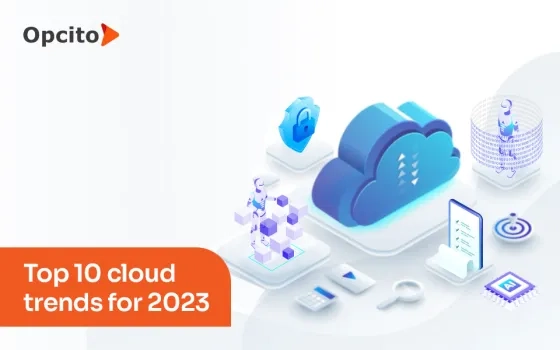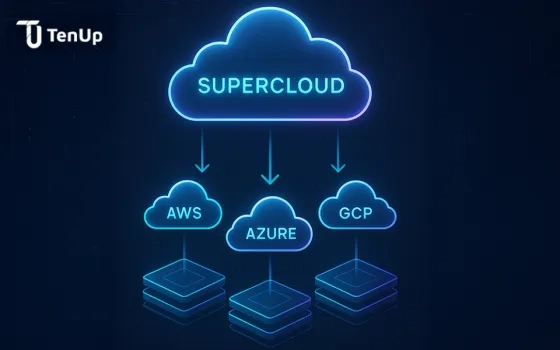Most of the revolutionary technological trends of recent times, like artificial intelligence, machine learning, and FinOps, have been greatly influenced by the widespread adoption of cloud computing. Gartner forecasts the worldwide public cloud end-user spending to reach nearly $600 billion in 2023, up from $490 billion in 2022. Because of its high potential for accessibility, usability, and efficiency, the cloud has led the "one to watch" technology lists of practically every analyst for the past 20 years. In the first generation of cloud computing, apps, storage, and the advent of software as a service were the focus points. IT teams improved their capability in the second iteration and modernized working procedures. What will be the focus of the next generation of clouds? Let's see the top ten cloud trends for 2023:
1. Rise of multi-cloud
Spreading workload enhances flexibility was one of the significant reasons for cloud adoption. Now with multi-cloud, we can not only spread the workload across multiple clouds as per convenience but also diversify the potential failure points. It reduces the potential risks associated with vendor lock-in – something organizations are increasingly becoming cautious about. Also, opting for more than one provider has proved to be beneficial in terms of expenditure. With multi-cloud, we can choose a cloud that best suits a particular service instead of hosting the entire product on one cloud. This can be beneficial to tailor services according to what best suits their business approach and specific geography. This will also, in turn, fuel innovation among the cloud service providers as they will have to augment their services to match the competition.
2. Cloud cost optimization
The use of the cloud is rising exponentially, as are the costs attached. A Gartner study shows that worldwide IT spending will grow 5.1% in 2023. But on the other hand, the recent signs of a slowing economy mean that organizations will resort to practices that will save the cloud costs without compromising their security and performance. Cloud services optimization and cost-effective offerings should be on the up in 2023. Additionally, efficient monitoring has always been the focal point for cost-efficiency, optimized resource management, and security. It won't be a surprise if we see a rise in innovation related to monitoring techniques, too, especially around cost and usage optimization.
3. More FinOps than ever
The world's largest investment banks expect global economic growth to slow further in 2023. Organizations will spend more on the cloud, but they will also closely monitor all cloud-related spending. They will seek to accelerate business value by refining how they consume the cloud. FinOps, a culture developed within enterprises to help them manage and optimize cloud costs by bringing DevOps, IT, and finance teams together to address the cloud costs across the organization collaboratively, will undoubtedly gain traction. It will enable organizations to drive financial accountability while boosting their business value. More investment can be foreseen in partnering with third-party platforms that help with cost optimization and cost management to understand their cloud spending accurately.
4. Data security
Cloud or no cloud, data security is undoubtedly a no-compromise prospect for all organizations. We've seen multiple instances of data breaches posing challenges to organizations. Multi-cloud environments, especially, are complex to manage and secure and risk facing a higher number of security breaches. Intelligent security around housing and transferring data should again be the most talked about the subject with the emergence of new techniques to safeguard the cloud space. Encryption and multi-factor authentication should become a new normal to combat breaches. Review of privacy policies, backups & DR systems will be at the forefront so that data losses can be minimized. A lot of stress will be given to security testing so loopholes can be exposed and patched beforehand. We will see more proactive security strategies than reactive security.
5. Data sovereignty to gain traction
Recent geopolitical tensions have forced organizations and governments to safeguard their data by housing it within their geographical boundaries. Countries will want to have little foreign control over their data. This means that 2023 will see more stringent rules and sharing laws laid down by governments around data sovereignty and privacy. Along with CCPA, EU, and GDPR, rules on data privacy and laws among countries will be more stringent than ever. We will see updated data encryption rules & policies, and data handling, storing, archiving, and destruction practices. This will result in organizations taking proactive steps to create their data handling & governance laws to ensure smooth integration and sharing across the IT landscape. Regarding open-source data communities, we will see improvements to Logical Replication, where users can set geo-fence subsets and other limits to restrict data to specific locations so that it can't be replicated and used anywhere else other than where intended.
6. Cloud in sports
Cloud computing has already entered the world of sports, and its influence heavily impacts organizers, teams, and athletes. Information about an athlete's diet, training activity, sleep, and game performance can be captured using specialized sensors to enhance their performance. The cloud is also used to improve the viewer experience. For example, Formula1 – the biggest single-seater formula racing event and arguably the most technologically advanced motorsport gets its insights powered by AWS, bringing fans closer to the racetrack and enhancing their experience with real-time analytics. Stadiums and venues, too, have begun adopting the cloud and will continue to adopt cloud technologies to improve the fan experience.
7. Responsible AI
As things stand, Artificial Intelligence has found its use for good and unethical practices. As the use of AI by rogue organizations and individuals for socially destructive objectives continue to grow in 2023, governments, industries, and academia will feel the need to govern AI for responsible and ethical use. Many organizations will begin taking steps toward ensuring their AI is trustworthy and reliable. To add to this, predictive AI will also show signs of promise. Predicting data breaches before they occur is essential to avoid a catastrophe. This will motivate organizations to develop predictive AI and blend it with other data security practices.
8. Increase in ML adoption
Machine Learning is a crucial technology from the usability and time & cost savings points of view. Cloud services providers themselves are heavily reliant on ML to provide better services. This includes handling vast and distributed networks that provide customers with storage resources, regulating the cooling and power systems in data centers, and creating security solutions to safeguard their and customer data. Organizations that seek high reliability from business-critical applications will adopt machine learning to ensure the desired performance is met. Sectors like education, search engines, digital marketing, and healthcare are already using machine learning to optimize their processes. We also expect leading cloud services providers like Google, Microsoft, and Amazon to continue their innovation and apply ML to create more cost-effective and efficient cloud services.
9. Low-code and no-code solutions
More innovative technologies and smarter developers behind those technologies are considering writing code from scratch and repetitive pieces of code as a waste of time. IT professionals may need more bandwidth to write large and complex programs. In other cases, the demand for skilled software developers, too, has increased the need for low-code/no-code platforms to come into the picture. These platforms allow users to attain greater coding agility while saving time and costs. Users have seen its benefits reflected within the organization and felt its positive impact trickle down to the end users. The effect of increased speed and a low chance of errors plays a huge role in customer experience. Reducing the need for complex coding is highly desired; thus, low-code no-code services will be a hit in 2023 and beyond.
10. XaaS cloud offerings mature in 2023
The market for everything as a service (XaaS) will grow because of growing businesses migrating to software, cloud-based services, and platforms, as well as consumer expectations for increased control over services they have enrolled to. The market's reach would be extended by growing cloud-based services and incorporating cutting-edge features like less downtime, automated management, and lower monitoring costs. The expansion of the XaaS industry in 2023 will also benefit from the growing interest in subscription-based business models. Users' advantages derived from XaaS are – cost savings, scalability, accessibility, faster implementation, quick modification, better security, and enhanced flexibility.
2023 will see governance and cloud data handling policies getting stringent. A lot of attention will be directed toward strengthening cloud security by evaluating gaps and addressing them with more robust measures. Detailed security features will now be available to enterprises and trickle down to the end users as well. AI and ML will advance even further and will become widely sought for. We will see broader AI, and ML inclusion as the world adopts more intelligent tech. They will change how cloud data is collected, secured, stored, and interpreted, paving the way for readymade AI models. The cloud will significantly change in the coming year as service providers adjust their services and organizations take proactive measures to remain competitive.


















